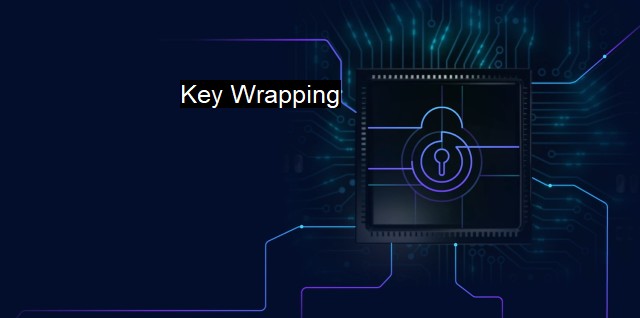What is Key Wrapping?
The Importance of Key Wrapping in Modern Encryption: How it Protects Cryptographic Keys and Mitigates Cybersecurity Risks
Key wrapping is a critical concept referring to the method of encrypting one secret key with another secret key to ensure highest level of protection and confidentiality of sensitive data. This acts as a protective layer that insulates the actual encryption key for safeguarding against potential attacks. The underlying secret key essentially becomes virtually inaccessible to nefarious actors, even in cases of data interception. The main intention behind key wrapping is to prevent the exposure of cryptographic keys that secure digital content, particularly in a large-scale enterprise-level network.Cryptographic keys are a vital element of the system for guaranteeing security and play an indispensable role in many functions such as access control, data encryption/decryption, and user authentication. Typically, the cryptographic keys need to be disseminated across different distributed systems, increasing the risk of theft or unauthorized access during transmission. Therefore, since the abstract nature of cybersecurity threats necessitates reliable protection against it, practicing key wrapping becomes an imperative measure.
Key wrapping operations involute algorithms that incorporate approved cryptographic algorithms. These ensure data protection through the wrapping mechanism. NIST, the National Institute of Standards and Technology in the US has specified standardized algorithms for key wrapping and unwrapping to ensure secure manifestation of the keys.
One example of a key wrapping algorithm is AES (Advanced Encryption Standard) Key Wrap Algorithm that uses a symmetric key cryptography mechanism. Another example is an RSA algorithm that uses an asymmetric method for encryption and decryption processes. Once the key wrapping parameters are defined, the initial plaintext key is encrypted into a wrapped key using the key-wrapping key, which is then ready to be safely transmitted.
In malicious scenarios involving interception, the hacked data would be inconsequential to the attacker, granting them access to encrypted, unusable material, unless they also managed to crack the key-wrapping key. typical key wrapping techniques plentifully increase the complexity of gaining access to the internal key used for encryption, implementing added levels of security.
Given this immediate nature of safeguarding sensitive information from unethical hacking, key wrapping also has an important role within the antivirus realm. An efficient antivirus system should include robust encryption components for optimal protection of data. Key wrapping becomes an inseparable part of the underlying architecture of these antivirus systems, transforming them into more reliant applications against cyber threats.
To illustrate, consider an antivirus equipped with key wrapping technology that fetches regular updates from a central server. Even if hackers managed to intercept these updates, without the decryption capacities, they are left with scrambled, unreadable data. Emphasizing key wrapping is, therefore, also featuring the capabilities of the antivirus software to provide more substantial protection.
Cybersecurity is a rapidly evolving sector that, although progressing with advanced defenses, is met with increasingly intricate cyber threats. Taking this progression into account, key wrapping has transformed in itself, morphing into diverse variants like authenticated encryption which includes an extra layer of validation of the recipient before unlocking the encryption key.
This crucial security method emphasizes the need for meticulous key management. The cost of losing keys would result in the permanent loss of the encrypted data. unwarranted exposure of wrapping keys or unmatched keys used for the wrapping process could also lead to decryption possibilities, making the security process obsolete. Therefore, employing robust cryptographic control and cautious key administration is pivotal in accentuating the benefits from key wrapping.
Key wrapping is an indispensable part of modern defensive mechanisms in cybersecurity and antivirus systems. While hacker methodologies elevate in slyness, the constant refinement of key wrapping algorithms and practices epitomizes the evolving security dynamics. With informed incorporation and vigilant management of these systems, a higher level of security can be materialized, which is imperative to maintain the privacy and integrity of classified data in a hyper-connected world.

Key Wrapping FAQs
What is key wrapping in cybersecurity?
Key wrapping is a technique used in cybersecurity to protect encryption keys from unauthorized access. It involves using a symmetric encryption algorithm to wrap the key with another key, called the wrapping key, that is known only to authorized parties.Why is key wrapping important in antivirus software?
Antivirus software needs to be able to detect and remove malicious code, but it also needs to protect the encryption keys used to secure sensitive data on a system. Key wrapping provides an extra layer of security to prevent attackers from intercepting or tampering with these keys.What are some common key wrapping algorithms used in cybersecurity?
Two common algorithms used for key wrapping are Advanced Encryption Standard (AES) Key Wrap and Triple Data Encryption Standard (3DES) Key Wrap. These algorithms provide strong encryption and are widely used in industry-standard security protocols.Can key wrapping be used to protect other types of sensitive information besides encryption keys?
Yes, key wrapping can be used to protect any type of sensitive information that needs to be secured, including passwords, digital certificates, and personal identification numbers (PINs). By wrapping the sensitive information with a secret key, it can be stored safely and securely on a system or transmitted over a network without fear of interception or unauthorized access.| | A | | | B | | | C | | | D | | | E | | | F | | | G | | | H | | | I | | | J | | | K | | | L | | | M | |
| | N | | | O | | | P | | | Q | | | R | | | S | | | T | | | U | | | V | | | W | | | X | | | Y | | | Z | |
| | 1 | | | 2 | | | 3 | | | 4 | | | 7 | | | 8 | | |||||||